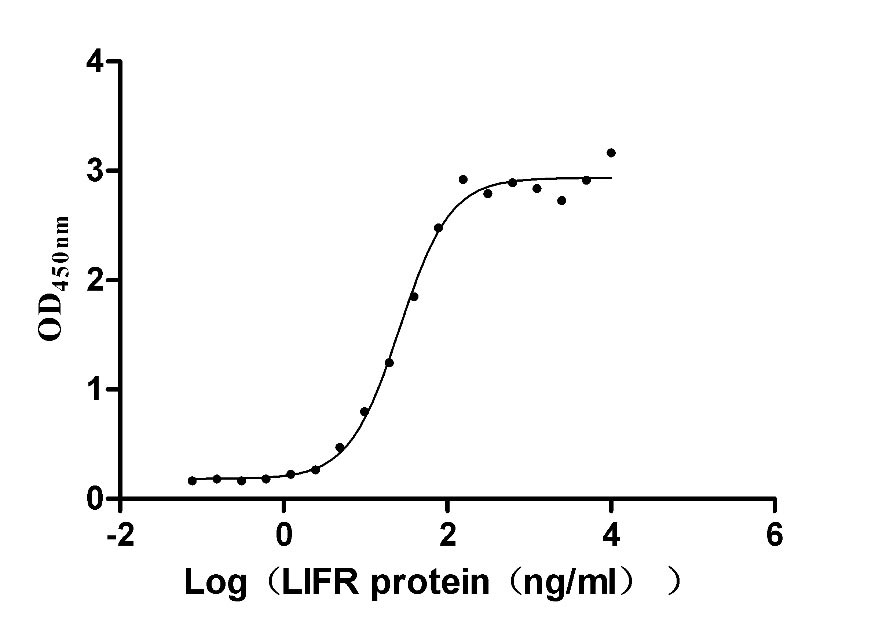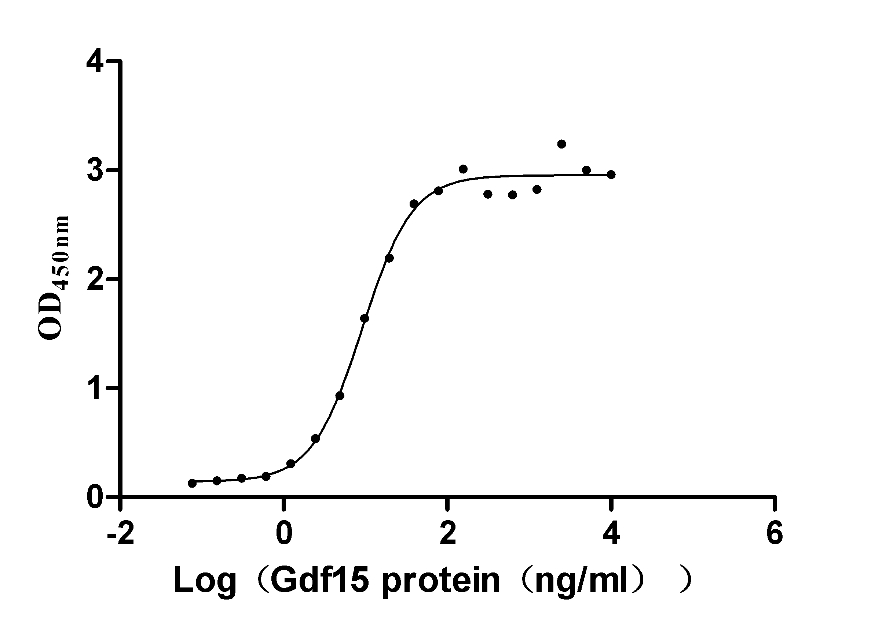Recombinant Clostridium botulinum Botulinum neurotoxin type B (botB), partial
In Stock-
中文名称:Recombinant Clostridium botulinum Botulinum neurotoxin type B(botB),partial
-
货号:CSB-YP318083CLQ
-
规格:¥2616
-
图片:
-
其他:
产品详情
-
纯度:Greater than 90% as determined by SDS-PAGE.
-
基因名:botB
-
Uniprot No.:
-
别名:botBBotulinum neurotoxin type B; BoNT/B; Bontoxilysin-B) [Cleaved into: Botulinum neurotoxin B light chain; LC; EC 3.4.24.69); Botulinum neurotoxin B heavy chain; HC)]
-
种属:Clostridium botulinum
-
蛋白长度:Partial
-
来源:Yeast
-
分子量:51.3kDa
-
表达区域:1-427aa
-
氨基酸序列MPVTINNFNYNDPIDNNNIIMMEPPFARGTGRYYKAFKITDRIWIIPERYTFGYKPEDFNKSSGIFNRDVCEYYDPDYLNTNDKKNIFLQTMIKLFNRIKSKPLGEKLLEMIINGIPYLGDRRVPLEEFNTNIASVTVNKLISNPGEVERKKGIFANLIIFGPGPVLNENETIDIGIQNHFASREGFGGIMQMKFCPEYVSVFNNVQENKGASIFNRRGYFSDPALILMHELIHVLHGLYGIKVDDLPIVPNEKKFFMQSTDAIQAEELYTFGGQDPSIITPSTDKSIYDKVLQNFRGIVDRLNKVLVCISDPNININIYKNKFKDKYKFVEDSEGKYSIDVESFDKLYKSLMFGFTETNIAENYKIKTRASYFSDSLPPVKIKNLLDNEIYTIEEGFNISDKDMEKEYRGQNKAINKQAYEEISKE
Note: The complete sequence including tag sequence, target protein sequence and linker sequence could be provided upon request. -
蛋白标签:N-terminal 6xHis-tagged
-
产品提供形式:Liquid or Lyophilized powder
Note: We will preferentially ship the format that we have in stock, however, if you have any special requirement for the format, please remark your requirement when placing the order, we will prepare according to your demand. -
缓冲液:Tris-based buffer,50% glycerol
-
储存条件:Store at -20°C/-80°C upon receipt, aliquoting is necessary for mutiple use. Avoid repeated freeze-thaw cycles.
-
保质期:The shelf life is related to many factors, storage state, buffer ingredients, storage temperature and the stability of the protein itself.
Generally, the shelf life of liquid form is 6 months at -20°C/-80°C. The shelf life of lyophilized form is 12 months at -20°C/-80°C. -
货期:3-7 business days
-
注意事项:Repeated freezing and thawing is not recommended. Store working aliquots at 4°C for up to one week.
-
产品描述:
The production of this Recombinant C. botulinum botB protein started with the botB gene synthesis. And then using recombinant DNA technology, the botB gene was inserted into an expression vector so that we could get the recombinant express plasmid of botB. Transform the plasmid into the cells of Yeast, culture the cells and we could get the desired Recombinant C. botulinum botB protein. But the work was not completed, protein purification and a strict QC system were performed in the last step. The purity is 90%+ determined by SDS-PAGE.
botB is a gene providing an instruction of making a protein named botulinum neurotoxin type B (BoNT/B) in clostridium botulinum. The protein encoded by this gene is also known as bontoxilysin-B and belongs to peptidase M27 family. This protein can be cleaved into two chains, including botulinum neurotoxin B light chain (LC) and botulinum neurotoxin B heavy chain (HC). It mainly targets motor nerve terminals and block neurotransmitter release, resulting in muscle paralysis.
-
Datasheet & COA:Please contact us to get it.
相关产品
靶点详情
-
功能:Botulinum toxin causes flaccid paralysis by inhibiting neurotransmitter (acetylcholine) release from the presynaptic membranes of nerve terminals of the eukaryotic host skeletal and autonomic nervous system, with frequent heart or respiratory failure. Precursor of botulinum neurotoxin B which has 2 coreceptors; complex polysialylated gangliosides found on neural tissue and specific membrane-anchored proteins found in synaptic vesicles. Receptor proteins are exposed on host presynaptic cell membrane during neurotransmitter release, when the toxin heavy chain (HC) binds to them. Upon synaptic vesicle recycling the toxin is taken up via the endocytic pathway. When the pH of the toxin-containing endosome drops a structural rearrangement occurs so that the N-terminus of the HC forms pores that allows the light chain (LC) to translocate into the cytosol. Once in the cytosol the disulfide bond linking the 2 subunits is reduced and LC cleaves its target protein on synaptic vesicles, preventing their fusion with the cytoplasmic membrane and thus neurotransmitter release. Binds to host peripheral neuronal presynaptic membranes via synaptotagmins 1 and 2 (SYT1 and SYT2). Toxin binds to the membrane proximal extra-cytoplasmic region of host SYT1 and SYT2 that is transiently exposed outside of cells during exocytosis; exogenous gangliosides enhance binding and subsequent uptake of toxin into host cells. Toxin uptake into neural cells requires stimulation (incubation with K(+) to stimulate SYT protein receptor exposure); subsequently the toxin colocalizes with its receptor in host cells with a concomitant decrease in target protein (synaptobrevin-2/VAMP2) immunoreactivity. Toxin uptake can be blocked by the appropriate synaptotagmin protein fragments and gangliosides in cell culture and in mice. BoNT/B is a 'coincidence detector'; it requires simultaneous binding to coreceptor GT1b and low pH to transform into a membrane-bound, oligomeric channel. Whole toxin only has protease activity after reduction which releases LC.; Has proteolytic activity. After translocation into the eukaryotic host cytosol, inhibits neurotransmitter release by acting as a zinc endopeptidase that cleaves the '76-Gln-|-Phe-77' bond of synaptobrevin-2/VAMP2, blocking neurotransmitter release. In vitro the LC only has protease activity after reduction.; Responsible for host epithelial cell transcytosis, host nerve cell targeting and translocation of light chain (LC) into host cytosol. Composed of 3 subdomains; the translocation domain (TD), and N-terminus and C-terminus of the receptor-binding domain (RBD). The N-terminus of the TD wraps an extended belt around the perimeter of the LC; it does not seem to protect the active site, but might prevent premature LC dissociation from the translocation channel and protect toxin prior to translocation. Has 2 coreceptors; complex gangliosides found primarily on neural tissue and host synaptotagmin-1 and -2 (SYT1 and SYT2) which bind simultaneously to adjacent but separate sites at the tip of the HC. HC alone partially prevents uptake of whole toxin by neural cells, and delays paralysis onset by 160%. Binding probably positions the TD for integration into the synaptic vesicle membrane. The HC forms channels at low pH that mediate transport of the light chain (LC) from the endocytic vesicle to the cytosol. Binds gangliosides GD1b and GT1b. Gangliosides are not only a coreceptor, but also required for uptake into nerve cells. HC alone binds to host receptor proteins SYT1 and SYT2. Interaction with SYT1 protein does not require SYT1 glycosylation. The HC C-terminus (approximately residues 1079-1291) interacts with host SYT2. Has higher affinity for SYT2 than SYT1. Significantly decreases uptake and toxicity of whole BoNT/B and BoNT/G.
-
亚细胞定位:[Botulinum neurotoxin type B]: Secreted. Host cell junction, host synapse, host presynaptic cell membrane.; [Botulinum neurotoxin B light chain]: Secreted. Host cytoplasm, host cytosol.; [Botulinum neurotoxin B heavy chain]: Secreted. Host cell junction, host synapse, host presynaptic cell membrane. Host cytoplasmic vesicle, host secretory vesicle, host synaptic vesicle membrane; Multi-pass membrane protein.
-
蛋白家族:Peptidase M27 family
Most popular with customers
-
Recombinant Human Leukemia inhibitory factor (LIF) (Active)
Express system: Mammalian cell
Species: Homo sapiens (Human)
-
Recombinant Mouse GDNF family receptor alpha-like (Gfral), partial (Active)
Express system: Mammalian cell
Species: Mus musculus (Mouse)
-
Recombinant Human Claudin-18.2 (CLDN18.2)-VLPs (Active)
Express system: Mammalian cell
Species: Homo sapiens (Human)
-
Recombinant Human Cannabinoid receptor 1 (CNR1)-VLPs (Active)
Express system: Mammalian cell
Species: Homo sapiens (Human)
-
Recombinant Human Myosin regulatory light chain 12B(MYL12B) (Active)
Express system: E.coli
Species: Homo sapiens (Human)
-
Recombinant Macaca fascicularis Zinc transporter ZIP6 isoform X1(SLC39A6),partial (Active)
Express system: Baculovirus
Species: Macaca fascicularis (Crab-eating macaque) (Cynomolgus monkey)





-AC1.jpg)













